 Story by Chris Hector and photos by Roz Neave
Story by Chris Hector and photos by Roz Neave
Mary Hanna has been instrumental in bringing many fine trainers to Australia, but one of the first was the Finnish star, Kyra Kyrklund. Mary had trained with Kyra when she was the trainer to the Swedish Dressage Squad at the famed Flyinge Stud, and they have remained firm friends ever since:
“We talk to each other on the email. She was a great influence on my riding because I was there in Sweden for a long time, and Kyra helped find the next horse, Limbo. I wasn’t looking for a horse at the time, I just fell over him.”
What do you think you got from Kyra?
“Her whole system is so clear. It’s not hidden in any myth or couched in terms you can’t understand. She is very clear in what she does, she has a system from beginning to end. Her system is very progressive, step-by-step. It’s a soft system, before I’d had a very German influence on my riding, and it was with Kyra that I learnt there were other ways to do it. You had to get the horse to do it, not by force but by feel, that was a turning point for me, to really understand that.”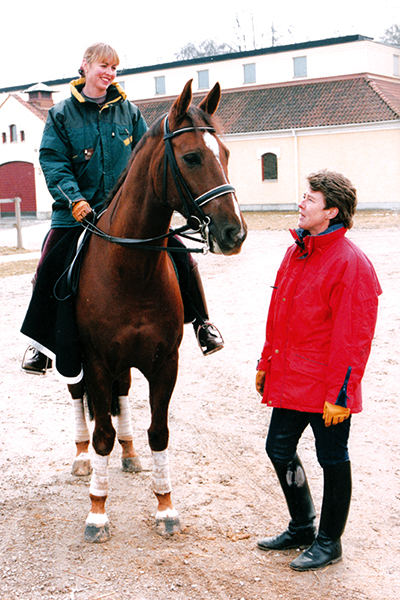
Mary and Mosaic with Kyra Kirkland at the famous Flyinge Stud in Sweden
“Then I learnt later from all the really top riders, that there is a big difference between Prix St Georges and Grand Prix – you might be able to make a horse do Prix St Georges, you can never make a horse do Grand Prix. As Herbert Rehbein used to say, ‘it’s the Alps’ – there’s not a great distance between Prix St Georges and Grand Prix, it’s just that you have to cross the Alps to get there. It’s true, many riders can ride Prix St Georges and you can make a horse do the test… I think in my eventing days it was always ‘I will make the horse do the test’ – I had that attitude, you will do this, I will make you. Then I had to change my ways when I realised, no you cannot force a horse to go Grand Prix.”
As you discovered after buying all those successful horses, that with Vancouver you had one that just did not want to play Grand Prix…
“And I tried to make Vancouver to do Grand Prix and he was not going to be made to do it – you had to do it with feel, and that was a big learning curve and a hard one but it was a good thing to learn. Mosaic was a bit of a lazy horse so he let me get away with it, but all the horses I’ve ridden in recent years are much hotter types of horses, and it is very different. The horses are different now, you have to ride with feel and tact.”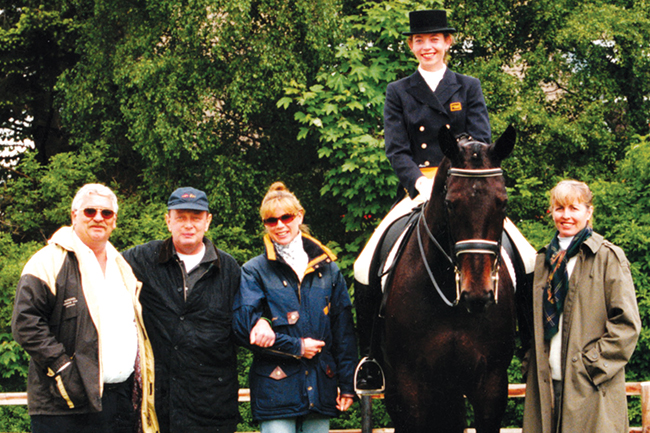
The dressage team for the 1998 WEG in Rome – left to right – Clemens Dierks, Australian coach; Herbert Rehbein, German coach; Nancy French; Rachael Sanna and Charisma, and Mary
How did you find Limbo?
“I was at Aachen with Mosaic, and Kyra was there. She was competing Limbo in the Prix St Georges, and he was owned by the Japanese. I really liked him, and it was at the time Japan was having a financial crisis, they had to sell the horse. Kyra said to me, ‘this horse will not pass a vet check’ – Rembering it was the same with Mosiac. I said ‘it must be okay!’ Kyra thought he was a really good horse, so I took him down to the vet check and he passed all his flexion tests… but he had chips. Still I bought him.”
And he came fairly quickly to the top?
“He’d had one or two starts Prix St Georges when I bought him and he was in Grand Prix in a very short time. We just hit it off, it was easy for him. He went to the World Championships in Spain in 2002, and he competed at two Olympics, Sydney and Athens. He was such a beautiful horse.”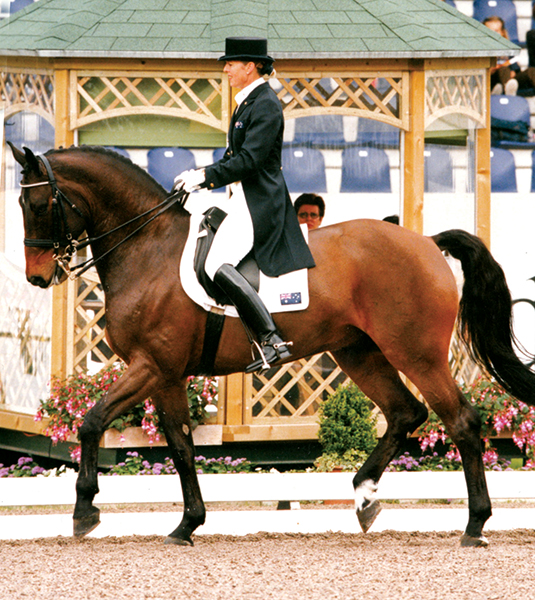
Competing at Aachen in 1999 – Mary and Limbo
It must have been heartbreaking to lose him on the way back from Athens…
“That was one of the biggest lows of my whole life. I felt so guilty because it was the first time I didn’t send a groom home with the horse. The first and only time. It was just circumstances, I had staff trouble at home and couldn’t spare Simone to stay with him because I had no staff at home. I thought I hope he’s okay, and of course, he was not okay. His temperature wasn’t taken, and I know if Simone or I had been there, he would have been okay. We would have got straight on to it, but I think it was several days before they realised how sick he was, and then it was too late… and of course, I’ve been a nervous wreck about travelling horses ever since.”
Your current up and coming horse, the stallion, Shiraz Black is from Germany?
“He’s a real tough German boy. That all came about more or less by accident – I’d bought exactly what I was saying to you I shouldn’t buy, I was in a hurry and bought a going horse, an advanced Prix St Georges horse. I took him home, we absolutely did not hit it off. I was arrogant enough to think I could fix some of his problems, and I couldn’t. He had problems with flying changes, which normally I’m pretty good with, but he had all sorts of canter problems, and I thought I’ve made a huge mistake. I bought him from PSI and so I sent him back, and in return I got two horses, that’s one of the great things about buying from Kasselmanns, I got the Londonderry mare who is lovely, and in foal at the moment, and Shiraz, as a two year old, so it turned out to be a great thing to do.”
So where is your real spiritual home – Holland or Germany?
“It’s different. I do love the Dutch horses I have to say. I went to Holland to buy Dutch horses, and came home with two, both half German, half Dutch. One is by a Dutch stallion out of a German mare, and one is by a German out of a Dutch mare. So? I like both places…”
You’ve trained with the Bartels in Holland, and more recently with Hubertus Schmidt in Germany, do you find it hard to reconcile the two systems?
“I think that all the top riders have so much in common in their training methods that the differences are subtle and small enough that it doesn’t cause me confusion. I pick up the things I love out of each of those trainers and I just have the greatest admiration for all the people I’ve trained with. Obviously, Bimbo, then Kyra. The Bartels were fantastic, I really enjoyed the time I spent there. They were wonderful people and I learnt a lot. I’ve absolutely adored my lessons with Anky and with Sjef, they are a little different but particularly with the Jazz horses, Sjef is a master. Hubertus is again like Kyra, he has a really clear system. But they all have in common the modern way of riding – that you don’t ride with force, you teach the horse to go off the leg not forcing or squeezing them, there’s many things in common. Even with Ulla, I remember Ulla talking about this whole thing of not squeezing the horse, you have to have a relaxed thigh and when you come with the leg, the horse has to react. That is common with all those trainers, it is the key thing that is different to the old fashioned German training which was more you used your leg strongly and made the horse go – with the modern trainers it is completely the opposite. You touch the horse with the leg, and the horse must react and go.”
The Ulla Salzgeber experiment seemed like a good idea at the time?
“I have to say I learnt an enormous amount from Ulla. I know she is a hard task master but I never regret one moment of training with her – she had so much to give. As with all the good trainers I’ve been to, they have things that ring in your ears, that you never forget.” Do you think it is an impossible task to find a National Coach?
“We need a good trainer because we are such a diverse group. I think we have to keep looking for the right person and somehow we’ve got to find some money, so we can pay someone decent. Maybe we have to think a little bit laterally, think about some sort of sponsorship where we can get a really good trainer – we can’t give up on it. We can’t sit here in Australia, especially now it is getting harder and harder to go to Europe, and think we are going to be okay, we need someone to work with us.”
You’ve always worked with Clemens Dierks…
“Clemens Dierks has done so much to help me – he has been the trainer I have always got back to. It was Clemens who got me to Atlanta… and I owe so much to Clemens who helps me all the time and in so many ways.”
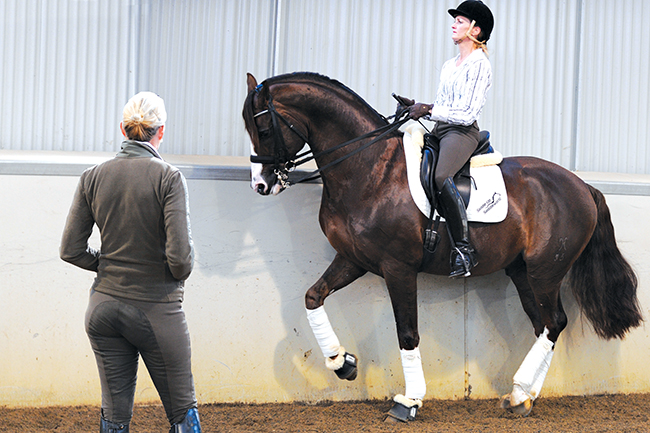 Starting out FEI
Starting out FEI
The next combination into the arena have real star quality – Maree Tomkinson and her imported stallion, Rodrigo. The horse has had some small tour starts and is looking the up and coming star, but Mary has her warmup routine, and it is the same for every horse – and they all have to start with a ‘normal’ trot:
“The trot in the beginning should just be the horse’s natural trot, you don’t want fancy trots to start, it is merely to let the horse stretch his muscles and get his body loose. It is only the warmup and it is important that he doesn’t over-use himself at the start. Just a normal trot. I don’t care if the horse hobbles along, as long as it is a normal trot that he is comfortable with, and once the horse is loose and relaxed and stretched, then we start the trot but not until then.”
“We do a little bit of trot, a little bit of canter, stretching as much as we can. Maree, just try to make him a fraction longer in the frame, to the connection, a little deeper and longer, stretch. Lots of changes of direction, and he still has to go into the connection. I want you to feel that he is taking the two reins a little bit more, he has to stretch down into the two snaffle reins and feel that he takes the connection. Come on a circle line, make sure you feel he is into the outside rein, flexed a little to the inside and stretching forward and down. A little bit deeper still, I don’t mind if he is behind the vertical in the warmup, that’s okay, as long as he is connected, that’s important.”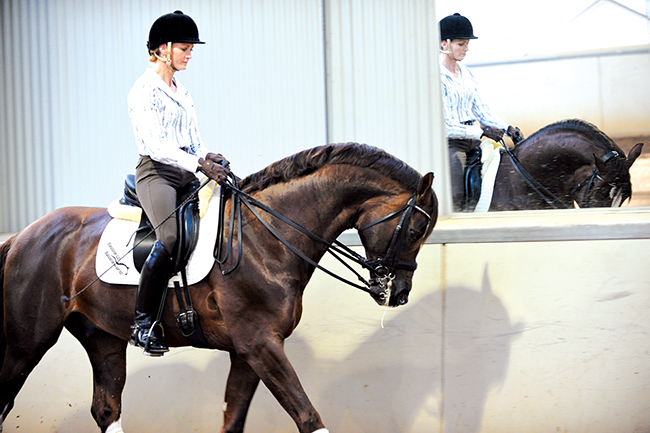
“If you want to counter flex, that’s fine, that loosens the back so counter flexion is good. Make some counter flexion on the long side to loosen him. Make sure when you counter flex that you don’t do it too quickly, do it over at least five or six steps at least. Counter flex now, so he goes into the right rein, flexes to the left and stays there, stay there, stay there. Now straighten and ride a correct corner. Exactly. That’s the best way to loosen the back. We’ll do that again on the next long side. Keep him connected to the two reins. Change rein and we’ll do it the other way.”
“He does tend in the beginning to hold the back a fraction, that’s really what we are working on, to get him to loosen the back. All horses hold their back a little in the beginning… He is starting to trot better now. Counter flex, good, the important thing in the counter flexion is that you don’t just pull the horse to the outside. When you counter flex, he’s got to step into what was your inside rein, it now becomes the outside rein. You are trotting on the left rein but you are loosening the horse to the right. You can see now, just by himself, he is moving better and better. We know he has got a big trot but I wouldn’t want her to do that big trot in the beginning. That’s what I want you to do. I don’t want you to force the trot. I want him to offer it to you because he is becoming loose and he can really start to trot a little bigger. Don’t force it – we are not ready for a big trot yet, let him take his time. We won’t do the bigger trot until we’ve done some canter.”
“Now a little bit of canter, still in warmup mode. We do the same in the canter, he doesn’t have to collect it yet, he just has to stretch over the back and come a little deeper than normal. Stretching down into the two reins, taking connection, very good. On the long side you can ride counter flexion. It is important when you counter flex in canter, the hind leg still follows the front leg. He should only flex through the neck, the hind leg and the front leg must still be straight. That’s a nice balanced canter and another counter flexion. He is just pushing the hind leg in a little bit when you counter flex – so you need to use your left leg a little bit to hold the back end a fraction, while you counter flex.”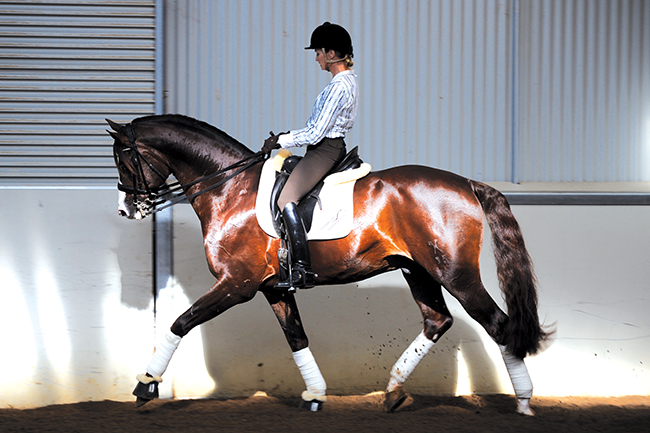
“Now do a little forward and back in the canter, get the feeling that the horse is in front of you. You come back a little with the seat, and when you go forward, I want you to open your knee and GO. Don’t squeeze him forward, you open your upper leg a fraction and if he doesn’t go, come with the lower leg but don’t squeeze him. Sit in, good, open your leg and forward. If you don’t get an immediate response you can come with the lower leg, so in the end he goes forward because you open the leg a little not because you squeezed him forward.”
“This is the same warmup routine that I use with all the horses, it doesn’t matter if they are Novice or Grand Prix. Now he looks loose in the neck, we want to see transitions where he comes back and sits a little bit more on the spot – sit and then go, open your leg, and go. Keep him a little deeper, we are still warming up, it’s not a competition frame yet.”
“Open him up a couple of times, I want to really see him go. That’s better, exactly. Again, he’s got to go a bit more, and come back and sit. Sit him a little extra and then really go one more time. Not so much that you lose rhythm and roundness, he must stay round when he sits. He has to stay round and through, he mustn’t go hollow when you ask him to sit.”
“Back to trot, and a few big steps of trot, then walk, relax, take a break.”
“Would you like to start with trot or canter today?”
“Trot.”
“Good. Get him to stretch forward and down in the walk, still connected into the snaffle rein.”
“Start rising in trot until you get the feeling you had at the end of the trot there, and when you get that, sit, and we’ll start to really put him together. Rising first, put him a little deeper, more in the warmup frame, then gradually put him together and then we start work.”
“Now you can sit. Don’t bring him back too much, first you’ve got to think about the rhythm of the trot. Ride the little half halts, building the trot all the time. Ride your own lines but keep up the little half halts. Now he is starting to carry a little bit more uphill, the little half halts should engage the hind legs and then have him coming up through the wither. One more leg yield each way because that is helping. Just gradually build on the trot. That’s a super trot now, you don’t need more, don’t over-ride it, it’s enough, it’s regular and it’s uphill.”
“You can start your lateral work as you please now because the trot is good enough. It’s enough Maree, I can see you thinking about asking for more, but it’s enough. Don’t lean back, sit upright, that is a good trot, very good in the frame.”
SHOULDER IN
“That’s got to have a little more flexion through the neck, don’t let him drop the inside ear.”
“Ride the corner better, more bend in the corner and then the shoulder in is easy. Better, that was a good corner. Steady, keep the outside rein steadier, outside hand down a fraction so the ears are level. Good. Little half halts on the short side but I shouldn’t be able to see them. That’s good, good swing, good crossing, finish with the hind leg. Always the little preparation. Every short side – use it to prepare for the next thing.
HALF PASSES
“That was a little steep for the first one that side. Can we do that again? And I want you to ride it a bit longer, with a bit more of the rhythm. He could have had more bend, that was very much sideways, and not enough with the bending. Don’t make your first half pass a Grand Prix half pass, just give him time to work into it. Bend him in the corner, use the short side to set it up. Half halt, and bend, and steady with the hands… and across. Forward and across, forehand, not so much with the hind leg, more with the front. You tried to ride the hind leg a little too much at the start. Start more with the forehand, and a little bit of hind leg at the end.”
“Good, much better, walk and pat him.”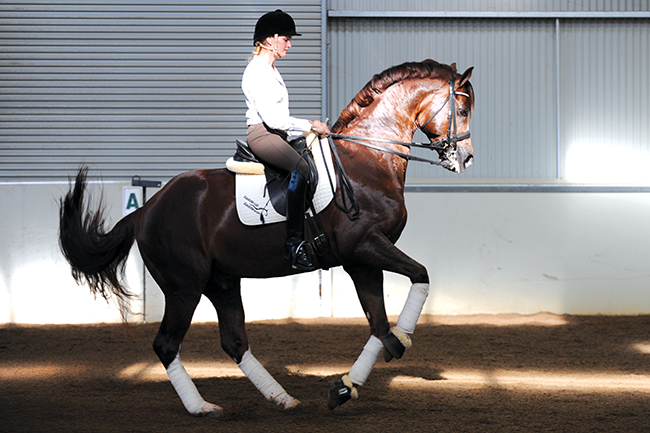
PIAFFE / PASSAGE
“Canter now or piaffe / passage?”
“Piaffe / passage.”
“Have a walk then warmup with a couple of piaffes. I always leave it up to the rider the order they work their horses. If they decide to canter, then I have an order I like to see the canter work in, but whether they do canter or piaffe / passage, that’s up to them because they know their own horse and they know what will develop the work the best. I always like to start with the things the horse does best and easiest, first, so you don’t get into any conflict early in the working session. I don’t like to leave the piaffe / passage to the end because then the horse is tired – I like to do it in the middle. But they are all different, it depends on the horse.”
“A few little easy piaffe steps to start with.”
Is it important to start with piaffe or passage, when you are teaching them?
“Most horses I start with a little piaffe. Not with Tango because he seems to piaffe much better out of passage, but with most of them, we start with piaffe. If you are doing passage all the time at first, you can end up with passage on the spot, we want the piaffe to be a piaffe. Maree is riding a stallion, and really has to feel that he is in front of her leg before she asks for piaffe, so she has decided to go forward and then come back to piaffe. Sometimes if you ask stallions out of a walk to piaffe, it is not easy, she’s got to get him thinking forward first.”
“Good, a little feeling of coming forward, step by step, it’s got to be a hoof print forward in each step. Now pat him and ride forward, then come back again. You can start some passage steps but not too much back with the passage, I want to see you forward in the passage, you have to really think of regular steps first. You can ride it forward and back, you can even ride a bit of medium trot. Be careful not to bring him back too much.”
“Next long side, medium trot, then come back to passage and I want it to be a forward passage. Half halt, collect, half halt, collect – now go forward and come back to passage. Tell me if he is getting too heavy Maree. Good, that is regular, only come back as much as we can keep him regular. Good, you’ve just got to work gradually back but keep the forward feeling. Come back now to piaffe, and passage out of piaffe. Very good. Back to piaffe, super, very good transition, keep the forward feeling coming out, catch him coming out. You didn’t quite catch him coming out then and he went a little hollow in the back. Before you come out you have to feel he is really over the back as you come out. Walk for a moment and give him a break…”
“I know we are not doing a really big passage, but I don’t want to do it yet, first we have to have him regular and develop it gradually.”
Maree explains her difficulty: “When I come out of piaffe, I get a bit stuck because he likes to stay in piaffe, then he takes that big step out not really passage, almost a trot…”
“Let’s work on that for a moment. So we are going to do a few steps piaffe, 3-4-5 steps, whatever, keeping him round, go out a few steps passage and then come back immediately to piaffe again. A little bit forward, a little bit back, a little bit forward, a little bit back. If he goes to run through the bridle, just halt.”
On cue, Rodrigo loses his roundness and rhythm coming out of the piaffe… “Now that moment, is the moment when he comes a bit flat coming out, keep him more through and then gradually forward. Better, exactly Maree, that was how I wanted him. Keep him through coming out, that is exactly right. Walk and pat him. That’s how you have to train. Sometimes you have to do it more on the spot, but that was much better, and you kept him through. I think what happens is, if you stay in piaffe too long, then he does get stuck, and when he is stuck, he is dropping the back a little bit, then when you go to come out, you can’t because he has dropped his back.”
“Do it exactly the same again on the other rein. It’s good to discuss it with you because you are sitting on the horse, I want to know what you are feeling.”
“Don’t lean back too much because that tells the horse to go forward. Keep him through as you come back, not too jerky coming back, smooth. Keep him through, he’s got to be more over the back there. He’s got to stay up with the back, not just up with the neck. Catch him as you come out, three steps passage, then back again, then on again, keep him through, on again, good, walk and pat. Don’t go on and on, or he’ll get too strong. That’s enough of that, have a relax and we’ll canter.”
“It was interesting because when you had him more through, it was much more regular behind. If you get irregular steps, it’s when he drops his back. It’s all about keeping him up under the saddle. Now canter.”
“Good frame, lots of little transitions, and only come back as much as you can keep the hind leg jumping and quick. Don’t come back so much that it becomes slow, and a little more through when you come back. That was a nice transition because he kept exactly the same rhythm and he is really stepping under himself now.”
“When you are ready, you can start with a half pass. A little bit rounder, keep him over the back, especially in the downwards transition, that’s the place where he likes to drop a little bit. That’s good what you did there – that little shoulder fore is very good preparation for the half pass, it really gets the hind leg under him. Super into it, now keep the canter a little quick again, and a bit more through, but you started the half pass really well. Be careful, you must keep the canter at the end. That’s how you’ve got to start your trot half pass, the way you started the canter half pass, that was exactly right, with that little shoulder fore. At the end you have to push the hind leg, almost in front, almost a renvers so you are ready for the next one when you go the other way in the Grand Prix test. Good, walk and pat, you don’t have to do that again.”
“We’ve been talking a lot about how – especially with stallions – it is important to keep your lower leg forward. The sensitive place for the horse is by the girth, the further back you kick him, the duller he is – or he is going against the leg.” “If you look at most of the good riders today, they ride with the lower leg a lot more forward than they did ten years ago. When you move your lower leg back, all you are doing is annoying the horse and making him go against your leg – it’s not the spot, especially with a stallion.”
CANTER PIROUETTES
“Do a little warm up, working pirouettes first. Don’t sit so much that he loses the jump. If he gets slow, go bigger. Go a little more forward, the outside hand down a fraction, and the moment he starts to get slow and high, you have to ride him forward again. Only ask as much as you keep a correct canter.”
“Then go on the circle and a little bit forward and back, with no travers, so he is sitting and keeping the hind leg quick. Only a little bit, you’ve got to keep that hind leg jumping – no travers – I want the hind leg quicker. It’s got to be quick/quick, quick/quick, when the hind leg is quick then come on the short diagonal and ride a working pirouette. Make him through, and the hind leg quick. Now when you come to ride the pirouette, be very soft in your hands, especially the inside hand, and ride a full working pirouette, but keep the hind leg quick. Very good, super. That’s exactly what I wanted. Walk, pat and come the other way.”
“Keep the hind leg quick, keep him through, he’s stepping well under there – open it if he gets slow, bigger, keep the hind leg quick again, and keep him a little deeper, put the neck down a little deeper – deep neck, we are only training – he must be over the back. It is when he stiffens the back that he starts the slow steps. Good, keep him deep then go forward if you get a step like that, and make him quick again, the hind leg following the front leg on the circle, a little forward and back, keep the hind leg quick and keep him deep. Okay, now come round on the short diagonal and ride the working pirouette, but make sure that he is sitting, and the neck is a little deep and he is over the back, quick, quick, not too small. That’s enough, good.”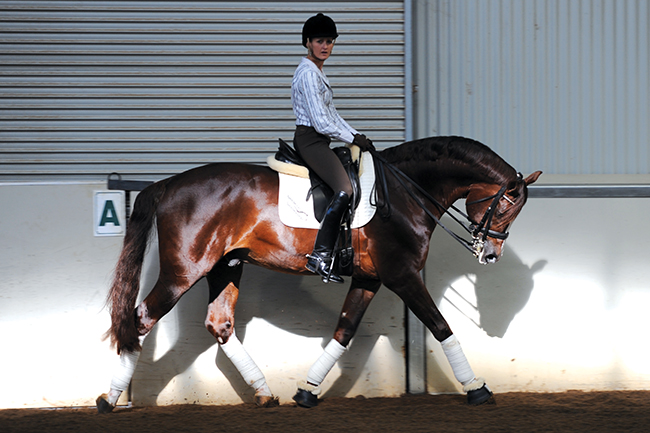
“When he gets slow, he slightly hollows the back and he comes too high in front, then he locks the back and then he gets really slow, so what you have to do then is put him down really deep and make the back loose. You had lessons with Ulla didn’t you? (YES) She used to do an exercise on the circle and you had to counter flex the horse in a pirouette – have you ever tried that with him? That could help because you know how he loosens his back when you counter flex, if you tried that in the pirouette exercise, he may loosen the back… or he may not. You have to try it and see.”
“I’ll stand in the centre, you come around me, just keep him extra deep, and bring the hind leg to me, and now counter flexion, hind leg to me, inside flexion, counter flex – now go out, you can’t do it too small. It is just to loosen the back. Walk and try it the other way but don’t come so close to me, stay quite a way out. Canter on and bring the hind leg to me and counter flex, good, good, normal flexion, counter flex. Very good. Much better, walk and pat him. I think you should work on that a little, he can’t lock his back against you then. It’s a good exercise for him, but it is quite hard work so don’t do it too long.” “We can just finish with some changes and I think you are done. Think about what we were talking about with the changes. You are going to collect, and sit into every change, you are not going to gallop through the changes, sit into every change and make the expression of the change by sitting in.”
“A really good canter is the first thing, really feel he is engaged and uphill. Really straight, even on two reins, good changes. Sit in a little bit on the short side, good, sit, sit, good. And SIT – good Maree. You got a little hectic at the end but he first changes were very good. Careful you were starting to throw your body a little, those first changes were really good and you sat in the middle of the horse. Sit in the middle of the horse, and sit. Just be calm. Keep him really through – maybe get him more through before you start. That’s good, walk and pat. When you had him really nicely collected and sat, they were good quality, when you started to think, I don’t know if I am going to make it, then he starts to get a little flat. You can’t make an issue out of them, you just have to be happy to get them at first and then develop the quality. And repeating it fifty times is not going to develop the quality. Thank you Maree…”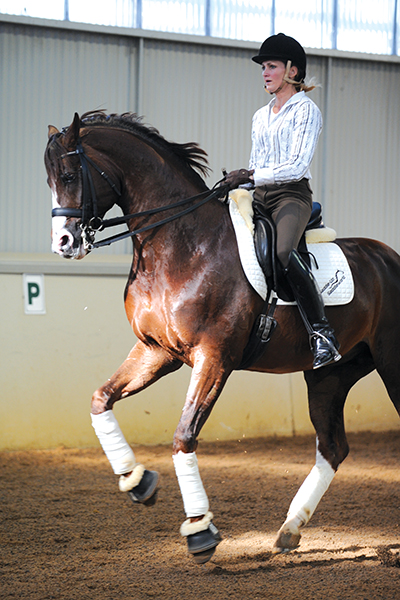
Maree on working with Mary:
“The whole time I’ve known Mary, right from the very beginning, she has always been really helpful and really supportive. When we were in Germany it was great having her there because she knew a lot more about the places we were going, and what you had to do, what competitions were good – and which weren’t – and I think we developed a fantastic friendship there. We could watch each other, and video each other at competitions. Then when we came home and I started doing the Victorian Squad clinics I felt that it really worked, I could really talk to her and she really listened if I said I felt this or felt that and she could help me with it. The thing is she listened instead of ‘I’m the coach and you are the student, just do what you are told’ – she really worked with me.” And the horse is going so well… “He’s brilliant, he’s got such a great mind, great trainability. If I ride him well he goes well, and if I don’t, that’s how it is.”
This article first appeared in the October issue of THM.
To view more articles with Mary, visit her who’s who page:
http://www.horsemagazine.com/thm/whos-who/hanna-mary/
